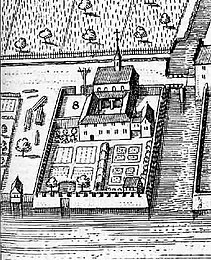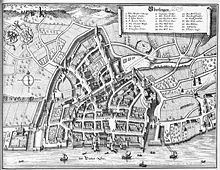Capuchin monastery in Überlingen
| Capuchin monastery in Überlingen | ||
|---|---|---|
 second Capuchin monastery in Überlingen around 1640
|
||
| medal | Capuchin | |
| founding year | 1619 | |
| Cancellation / year | 1806 | |
| Start-up | new order | |
| Patronage | Virgin Mary | |
| location | ||
| country | Germany | |
| region | Baden-Württemberg | |
| place | Überlingen | |
| Geographical location | 47 ° 46 ' N , 9 ° 9' E | |
|
|
||
| Situation in Germany | ||
The Überlingen Capuchin Monastery is a former and largely abandoned monastery of the Capuchin order . It existed from 1619 until secularization in 1806 and was one of the earliest settlements of the Swiss Capuchin Province on Lake Constance . Of the convent buildings , only the profaned and heavily redesigned monastery church remains today .
history
Monastery time
The Swiss Capuchin Province began around 1600. to spread out on Lake Constance. In 1613 the provincial chapter considered the imperial city of Überlingen as a location for a new settlement, which was welcomed by the Überlingen magistrate. The city provided the order with a building site outside the western city wall in front of the Grundtor (today in the area of Bahnhofstrasse No. 5), and in April 1619 the foundation stone was laid in the presence of numerous guests and the abbot of the Salem Abbey, Thomas I. After the construction work, financed mainly by donations , was completed in 1621, the Constance Auxiliary Bishop Johann Jakob Mirgel was able to consecrate the monastery church in honor of the Sacrifice of the Virgin Mary and the Fathers moved into their monastery on September 8th .
When the Thirty Years War penetrated Lake Constance and in 1634 the Swedish general Gustaf Horn and the Württemberg commander Konrad Widerholt and his troops unsuccessfully besieged Überlingen , the Capuchin monastery directly in front of the city wall served as a base for the besiegers, which meant that the entire convent building after the withdrawal of the troops were canceled for security reasons through the city. The friars were given emergency quarters in the Überlingen city area. Due to the apparent relaxation of the military situation, the monastery was consecrated at the old location on April 29, 1640, but was demolished three years later, as a new (this time successful) attack threatened by repeated attempts and the city was consequently occupied. This second monastery building only existed for three years, but was depicted on the copper engraving city view of Überlingen around 1640/43 by Matthäus Merian in the Topographia Sueviae ( Topographia Germaniae ), so that one can still get an impression of how the second monastery complex, for example looked.
Only after the Peace of Westphalia was the city council able to deal with the new construction of the Capuchin monastery and in 1651 decided that the new construction should now be carried out under the protection of the Überlingen city wall. The new building site was in the fisherman's suburb on Steckenmarkt , bordering the lake to the south. The foundation stone was laid on August 23, 1654. The third monastery building, once again financed by donations from the citizens of Überlingen, including a baroque hall church with a rectangular choir and a large monastery garden , was finally consecrated on October 27, 1658 by Prince Bishop Franz Johann Vogt of Altensumerau and Prasberg with the patronage of the two previous buildings.
Above all through the events of the Thirty Years 'War and the two destruction of the monastery buildings, the Capuchins in the imperial city, which remained Catholic , enjoyed great popularity until secularization, which can be proven through repeated donations to the order as well as the memberships of several citizens' sons. Since the founding of the Upper Austrian Capuchin Province in 1668, the Überlingen Convention has been regarded as a “ reservoir of the order's own offspring ”. In 1751 they dedicated a small chapel attached to their monastery to the holy religious priest Fidelis von Sigmaringen . The Fideliskapelle gave its name to the neighboring city gate (previously called Rudlfstor ) in the inner city wall ring ( Fidelistor , also known as Kapuzineror ; demolished in 1865). After the establishment of the Swabian Capuchin Province in 1781, the monastery was incorporated there.
In the course of secularization at the beginning of the 19th century, the monastery, still inhabited by twelve priests and four brothers, was first awarded to the Teutonic Order until it came into the possession of the House of Baden in 1805 . As early as the spring of 1806, Baden had the abolition of the Capuchin monastery, the remaining friars were given the abolished Überlingen Franciscan monastery as an apartment from 1809 . In 1817 four brothers lived there, three years later the last of them died there. The remaining remains of the monastery library became part of the Leopold-Sophien-Bibliothek in 1832 .
tasks and activities
The work of the Capuchins in Überlingen comprised the tasks typical of the mendicant order such as pastoral activities, sermons and poor relief . Her pastoral care was not only effective in the imperial city, but also in neighboring areas such as the Upper Austrian Landgraviate of Nellenburg . The order made a particular contribution to the care of plague sufferers during an epidemic in 1635. Individual members of the order also endeavored to promote the city's school facilities, for example Father Salesius Wiener, who set up a " normal school " in 1786 (in contrast to the Franciscans in Überlingen who ran the Latin School ). This normal school was a basis for the later elementary school .
After secularization
In 1809, the Baden government sold the former Capuchin monastery to an innkeeper from Überlingen, who set up a bathing establishment with an inn " Zum Schwanen ", which was fed by the neighboring mineral spring. At the same time, the partial demolition of the monastery buildings began in order to be able to finance the bathroom by selling the materials.
After the economic decline of the “ Zum Schwanen ” bathing establishment , the city acquired the entire facility in 1818. But shortly afterwards it came back into private hands. At this time the Capuchin Church was finally completely cleared out (the altar was moved to St. Martin's Church in Sipplingen , but was replaced in 1896) and in connection with the construction of the neighboring Bad-Hotel, around 1825, the remains of the monastery buildings were demolished. The now vacant area of the abandoned convent building with the former monastery garden was redesigned over time (around 1830 and 1861) into today's Badgarten (also known as the spa garden ).
Only the profaned church was preserved and served for around a hundred years as a " bath barn " and place of accommodation for the less well-to-do bathers of the bath hotel. Over time, all evidence that the building was used as a baroque mendicant order church for around 150 years was removed (among other things, roof turrets , stucco and vaults were removed, windows bricked up and reshaped). Only the shape of the building and a few window openings reveal the original purpose. In 1851 the church came back into municipal ownership. Around 1910, used it for some time as theater - and concert hall and the rest of the 20th century, mainly as a coach house , storage room , workshop and at times as a magazine .
Todays use
The Kapuzinerkirche, which is still owned by the city, has been used since a partial, rather superficial restoration in 2002/2003 (as in 1910) as a location for cultural events, including (in cooperation with the Konstanz Theater ) as a venue for the summer theater since 2003 .
Due to the danger of collapse of the ailing roof structure , the Capuchin Church had to be completely closed in December 2017. Renovation measures are currently planned. Due to the closure, the summer theater had to move to a mobile pavilion in 2018 .
literature
- Alfons Semler: Überlingen - Pictures from the history of a small imperial city. Oberbadischer Verlag, Singen 1949.
- Hermann Schmid: The secularization of the religious houses in Überlingen in the years 1803-1820. Writings of the Association for the History of Lake Constance and its Surroundings 94th Jg., Stettner, Lindau 1976, ISSN 0342-2070 .
- B. MAYER OFM Cap .: Capuchin monastery in Überlingen. In: The Capuchin Monasteries in Front Austria. In: Helvetia Franciscana , issue 12, pages 357–367, St. Fidelis-Buchdruckerei, Lucerne 1977.
- Wilfried Enderle: Confession formation and council regiment in the catholic imperial city Überlingen (1500-1618) in: Publications of the commission for historical regional studies in Baden-Württemberg B 118, Stuttgart 1990
- Alois Schneider, Regional Council Stuttgart, State Office for Monument Preservation, City of Überlingen (ed.): Archaeological City Register Baden-Württemberg Volume 34 Überlingen. Regional Council Stuttgart State Office for Monument Preservation 2008, ISBN 978-3-927714-92-2 .
Web links
- Kapuzinerkloster Überlingen on kloester-bw.de
- Capuchin monastery in Überlingen on leo-bw.de
Individual evidence
- ↑ Information on culture in the Capuchin
- ^ Website of the summer theater
- ↑ Martin Baur and Martin Deck: Massive damage to the roof: Kapuziner is blocked for events In: Südkurier from January 10, 2018
- ↑ Hanspeter Walter: Ailing Kapuzinerkirche: a piece of jewelry threatens to crumble In: Südkurier from January 31, 2018
- ↑ Martin Deck: Sommertheater: Rat overvotes Stadt In Südkurier from April 14, 2018
- ↑ Stefan Hilser: Preparations for the Überlinger Kultursommer: A culture pavilion is being built in Südkurier on July 28, 2018


